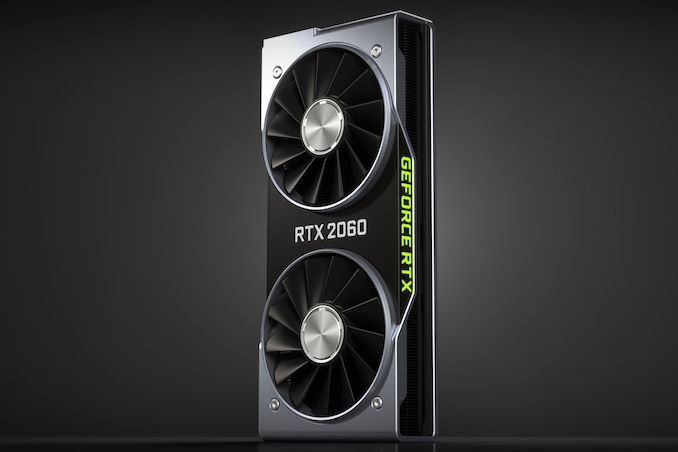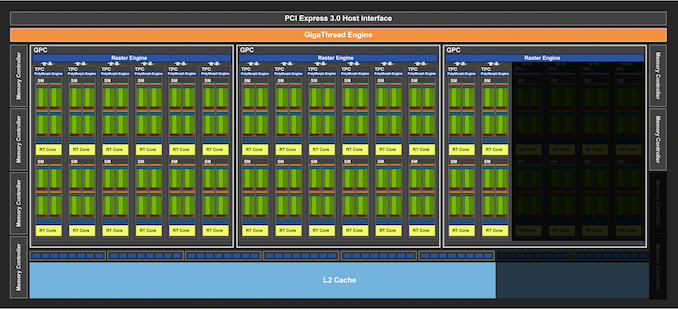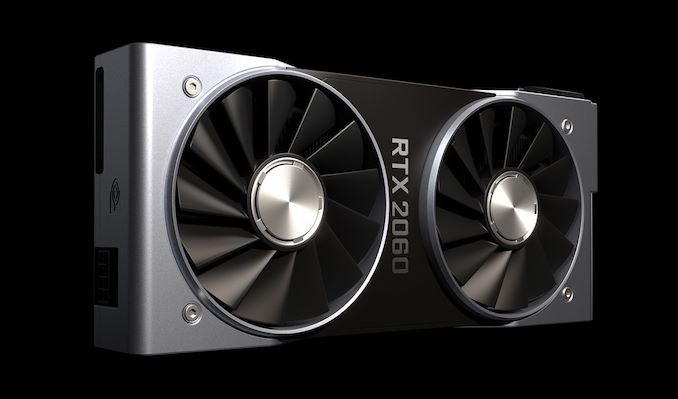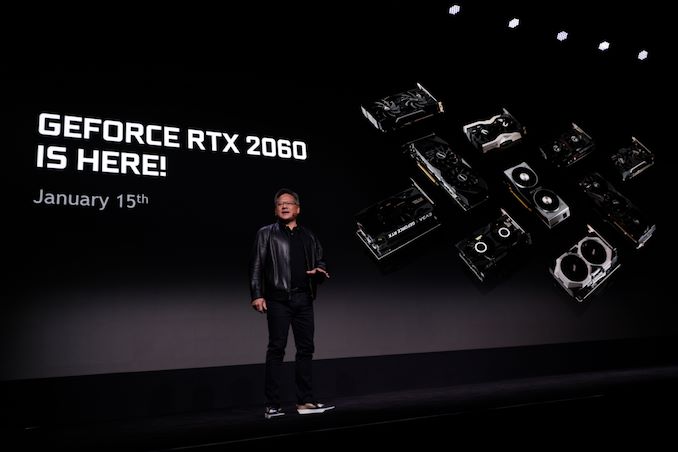NVIDIA Announces GeForce RTX 2060: Starting At $349, Available January 15th
by Ryan Smith on January 7, 2019 2:15 AM EST
Kicking off CES 2019 with a surprisingly announcement-packed keynote session, NVIDIA this evening has announced the next member of the GeForce RTX video card family: the GeForce RTX 2060. The newest and now cheapest member of the RTX 20 series continues the cascade of Turing-architecture product releases towards cheaper and higher volume market segments. Designed to offer performance around the outgoing GeForce GTX 1070 Ti, the new card will hit the streets next week on January 15th, with prices starting at $349.
We don’t yet have top-to-bottom specifications for the card, but based on the information NVIDIA has released thus far, it looks like the GeForce RTX 2060 is based on a cut-down version of the TU106 GPU that’s already being used in the GeForce RTX 2070. This is notable because until now, NVIDIA has used a different GPU for each RTX card – TU102/2080TI, TU104/2080, TU106/2070 – making this the first such card in the family. It’s also a bit of a shift from the status quo for GeForce xx60 parts in general, which have traditionally always featured their own GPU, with NVIDIA going smaller to reduce costs.
| NVIDIA GeForce Specification Comparison | ||||||
| RTX 2060 Founders Edition | GTX 1060 6GB | GTX 1070 | RTX 2070 | |||
| CUDA Cores | 1920 | 1280 | 1920 | 2304 | ||
| ROPs | 48? | 48 | 64 | 64 | ||
| Core Clock | 1365MHz | 1506MHz | 1506MHz | 1410MHz | ||
| Boost Clock | 1680MHz | 1709MHz | 1683MHz | 1620MHz FE: 1710MHz |
||
| Memory Clock | 14Gbps GDDR6 | 8Gbps GDDR5 | 8Gbps GDDR5 | 14Gbps GDDR6 | ||
| Memory Bus Width | 192-bit | 192-bit | 256-bit | 256-bit | ||
| VRAM | 6GB | 6GB | 8GB | 8GB | ||
| Single Precision Perf. | 6.5 TFLOPS | 4.4 TFLOPs | 6.5 TFLOPS | 7.5 TFLOPs FE: 7.9 TFLOPS |
||
| "RTX-OPS" | 37T | N/A | N/A | 45T | ||
| SLI Support | No | No | Yes | No | ||
| TDP | 160W | 120W | 150W | 175W FE: 185W |
||
| GPU | TU106? | GP106 | GP104 | TU106 | ||
| Architecture | Turing | Pascal | Pascal | Turing | ||
| Manufacturing Process | TSMC 12nm "FFN" | TSMC 16nm | TSMC 16nm | TSMC 12nm "FFN" | ||
| Launch Date | 1/15/2019 | 7/19/2016 | 6/10/2016 | 10/17/2018 | ||
| Launch Price | $349 | MSRP: $249 FE: $299 |
MSRP: $379 FE: $449 |
MSRP: $499 FE: $599 |
||
In any case, let’s dive into the numbers. The GeForce RTX 2060 sports 1920 CUDA cores, meaning we’re looking at a 30 SM configuration, versus RTX 2070’s 36 SMs. As the core architecture of Turing is designed to scale with the number of SMs, this means that all of the core compute features are being scaled down similarly, so the 17% drop in SMs means a 17% drop in the RT Core count, a 17% drop in the tensor core count, a 17% drop in the texture unit count, a 17% drop in L0/L1 caches, etc.
Unsurprisingly, clockspeeds are going to be very close to NVIDIA’s other TU106 card, RTX 2070. The base clockspeed is down a bit to 1365MHz, but the boost clock is up a bit to 1680MHz. So on the whole, RTX 2060 is poised to deliver around 87% of the RTX 2070’s compute/RT/texture performance, which is an uncharacteristically small gap between a xx70 card and an xx60 card. In other words, the RTX 2060 is in a good position to punch above its weight in compute/shading performance.
However TU106 has taken a bigger trim on the backend, and in workloads that aren’t pure compute, the drop will be a bit harder. The card is shipping with just 6GB of GDDR6 VRAM, as opposed to 8GB on its bigger brother. The result of this is that NVIDIA is not populating 2 of TU106’s 8 memory controllers, resulting in a 192-bit memory bus and meaning that with the use of 14Gbps GDDR6, RTX 2060 only offers 75% of the memory bandwidth of the RTX 2070. Or to put this in numbers, the RTX 2060 will offer 336GB/sec of bandwidth to the RTX 2070’s 448GB/sec.
And since the memory controllers, ROPs, and L2 cache are all tied together very closely in NVIDIA’s architecture, this means that ROP throughput and the amount of L2 cache are also being shaved by 25%. So for graphics workloads the practical performance drop is going to be greater than the 13% mark for compute throughput, but also generally less than the 25% mark for ROP/memory throughput.
I also have some specific concerns here about the inclusion of just 6GB of VRAM – especially in an era where game consoles are shipping with 8 to 12GB of shared RAM – but this is something we can look at later with the eventual review.
Moving on, NVIDIA is rating the RTX 2060 for a TDP of 160W. This is down from the RTX 2070, but only slightly, as those cards are rated for 175W. Cut-down GPUs have limited options for reducing their power consumption, so it’s not unusual to see a card like this rated to draw almost as much power as its full-fledged counterpart.
Past that, looking at NVIDIA’s specifications there are no feature differences between the RTX 2060 and RTX 2070. The latter for example already lacked SLI support, so there’s nothing to take away here. Other than being slower and cheaper than its bigger sibling, the RTX 2060 offers all the features we’ve come to expect from the Turing architecture family.
In terms of card design, next week’s launch is going to be a simultaneous reference and custom card release. NVIDIA will be releasing a Founder’s Edition card with their usual stylings – and in the pictures NVIDIA has released, it looks exactly like the RTX 2070 – while board partners have already worked with the TU106 GPU for a few months now thanks to RTX 2070, and have used the time to gain the experience needed to design their own boards. Like the custom RTX 2070 boards that have since launched, expect these cards to run the gamut from petite, mITX-sized cards with a single fan to large, tri-fan monsters.
Hardware aside, while NVIDIA is calling this an xx60 class card, the price tag and general power requirements for the RTX 2060 make it feel like it’s out of place. The xx60 series has traditionally been NVIDIA’s mainstream cards; and up until the launch of the GTX 1060 6GB, these were typically around $200. GTX 1060 6GB went to the high end of this scale at $249 for custom cards (and a whopping $299 for the Founders Edition), however the $349 RTX 2060 is now well outside of the mainstream sweet spot for pricing. With 3 other GeForce cards above it, it may not be high-end, but it’s definition an enthusiast card.
This also means that performance comparisons to the GTX 1060 feel similarly out of place. With 1920 CUDA cores the RTX 2060 is going to be significantly faster than the GTX 1060, but it also costs $100 more and draws 30W more power. So if anything, this feels like the new GTX 1070 (original MSRP $379) than it does the new GTX 1060. We’ll have to see what real-world performance is like when we get to review the new card, but thus far it looks like NVIDIA is going to be keeping their general price/performance curve for the RTX 20 series, meaning that in terms of performance in current games, the card is only going to be a mild improvement over the GeForce GTX 10 series card it replaces at this price tier.
Though even if the performance improvement is mild, it will significantly alter the competitive landscape. If NVIDIA’s GTX 1070 Ti-like performance claims are valid, then it’s going to undermine AMD’s Vega 56/64 cards, and the company will need to respond if they want to keep holding a piece of this market.
All told then, the value proposition argument for the RTX 2060 looks to be very similar to the rest of the RTX 20 series: NVIDIA is betting consumers will be willing to pay a premium for the Turing architecture’s next-generation features – mainly ray tracing acceleration and the various applications of the tensor cores. Which is why NVIDIA needs to continue to promote these features, bring developers on board, and sell the image quality improvements in general. Still, even NVIDIA seems to realize that this isn’t going to be easy, which is why they’re also launching a new GeForce game bundle program that will include the new RTX 2060, where buyers can get a free copy of either Battlefield V or Anthem.
The GeForce RTX 2060 will be hitting retail shelves next week on January 15th, with prices starting at $349. And we intend to take a look at this new card very soon, so please stay tuned.














45 Comments
View All Comments
Manch - Monday, January 7, 2019 - link
$399 is VEGA 64/1080 territory ATM. Which RTX title? The ones that are all 30$ if that now? Still not much of a value add. It's cut down RT will make that useless, and the 6GB will hamper it compared to a 1070/Ti. The 60 series has gone up in price again, so I don't see the midrange value. DLSS may be valuable but I want to see 8GB at least at that price.jjj - Monday, January 7, 2019 - link
If same die as 2070, then 445 mm2 paired with 6GB GDDR vs 1070 TI at 314mm2 paired with 8GB.They are taking a risk ,large die when the software for new features is not there but they can afford it since AMD's Vega is even costlier. Can AMD rush 7nm Vega and Navi since TSMC can ramp 7nm sooner than GloFo?
darkswordsman17 - Monday, January 7, 2019 - link
Vega 20 has already been in production, but it is an enterprise chip, so its not gonna be getting cheap enough to do anything about Nvidia's RTX prices. We don't know about Navi (rumors say it could launch in a few days at AMD's CES keynote, availability I think is probably at least 2-3 months out though), but I think its a safe bet that it'll beat Nvidia's 7nm offerings to market (I don't expect Nvidia 7nm til the end of the year and think it'll be Volta situation where it'll be just for Enterprise at first; not really based on anything just my own hunch).Er, GF killed their 7nm.
piroroadkill - Monday, January 7, 2019 - link
Why wouldn't you just buy a 1070 Ti? Clearly the price/perf champion at the moment. NVIDIA is just ruining the market with their newer cards. "Let's just bump the prices a bunch, people'll buy 'em anyway"... And they're right..darkswordsman17 - Monday, January 7, 2019 - link
I'd say wait at least to see what AMD does, rumors have said they'll announce or maybe even launch Navi during their keynote in a few days, and that it should offer ~1080GTX/Vega 64 performance for $249.But ignoring that, the 1070/Ti would be about the best options if the price is right (~$300?)
I'm not so sure that people are or will. Definitely could use Navi info and hopefully it is sooner than later and lives up to the rumors, even if you're wanting an RTX card as it should help get Nvidia's prices to become more reasonable.
StevoLincolnite - Monday, January 7, 2019 - link
Navi is just an iterative update to Graphics Core Next. Don't expect miracles.Will be interesting to see if AMD FINALLY gets Draw Stream Binning Rasterization happening though...
Yojimbo - Monday, January 7, 2019 - link
Navi should be able to approach 2060 performance without using HBM2, so it will allow AMD to compete on price/performance in that segment.darkswordsman17 - Monday, January 7, 2019 - link
I believe AMD has said it is a new architecture, distinct from GCN. I don't know that means all that much since I'm sure its built on their previous stuff like all their GPUs have been, but it seems to indicate that it won't be locked to the same ratios that GCN was.I don't think its expecting miracles to get that level of performance. With the 7nm shrink, it should be able to easily match Vega 64's rasterization throughput, by equal or more stream processors, and equal or higher clock speeds. Memory bandwidth should be reasonably close as well since GDDR6 will nearly or will double Polaris memory clock rates on equal bus, so 400-500GB/s bandwidth should definitely be possible (Vega 64 had ~480GB/s bandwidth).
Yojimbo - Monday, January 7, 2019 - link
I wouldn't expect Navi before late quarter 3 or early quarter 4, judging by AMD's history.darkswordsman17 - Monday, January 7, 2019 - link
I wouldn't base things too much on AMD's history. We'll find out in a couple of days, but there's been quite a bit of rumors though that AMD is going to have Navi out 1H (supposedly they even wanted to have it out in Q1). I'm not basing buying decisions on it, but I'm expecting Zen 2 based Ryzen and Navi will launch end of Q1/start of Q2.